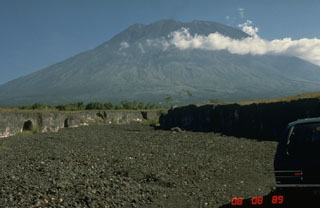Report on Agung (Indonesia) — 6 June-12 June 2018
Smithsonian Institution / US Geological Survey
Weekly Volcanic Activity Report, 6 June-12 June 2018
Managing Editor: Sally Sennert.
Please cite this report as:
Global Volcanism Program, 2018. Report on Agung (Indonesia) (Sennert, S, ed.). Weekly Volcanic Activity Report, 6 June-12 June 2018. Smithsonian Institution and US Geological Survey.
Agung
Indonesia
8.343°S, 115.508°E; summit elev. 2997 m
All times are local (unless otherwise noted)
PVMBG reported that during 1 May-7 June activity at Agung remained at a relatively high level. Emissions were mostly water vapor, occasionally with ash. In general, tiltmeter and GPS showed long-term deflation since December 2017, though inflation began to be detected the second week of May; deformation analysis indicated that magma continued to accumulate about 3-4 km below the crater. Low- and high-frequency earthquakes also suggested rising magma. Sulfur dioxide flux was 190-203 tons/day, and thermal anomalies in the crater were identified in satellite data. The erupted volume of lava was estimated to be 23 million cubic meters, equivalent to about a third of the total crater volume. At 2214 on 10 June an event generated an ash plume that drifted W at an unspecified altitude. The Alert Level remained at 3 (on a scale of 1-4) and the exclusion zone was stable at a 4-km radius.
Geological Summary. Symmetrical Agung stratovolcano, Bali's highest and most sacred mountain, towers over the eastern end of the island. The volcano, whose name means "Paramount," rises above the SE rim of the Batur caldera, and the northern and southern flanks extend to the coast. The summit area extends 1.5 km E-W, with the high point on the W and a steep-walled 800-m-wide crater on the E. The Pawon cone is located low on the SE flank. Only a few eruptions dating back to the early 19th century have been recorded in historical time. The 1963-64 eruption, one of the largest in the 20th century, produced voluminous ashfall along with devastating pyroclastic flows and lahars that caused extensive damage and many fatalities.
Source: Pusat Vulkanologi dan Mitigasi Bencana Geologi (PVMBG, also known as CVGHM)

